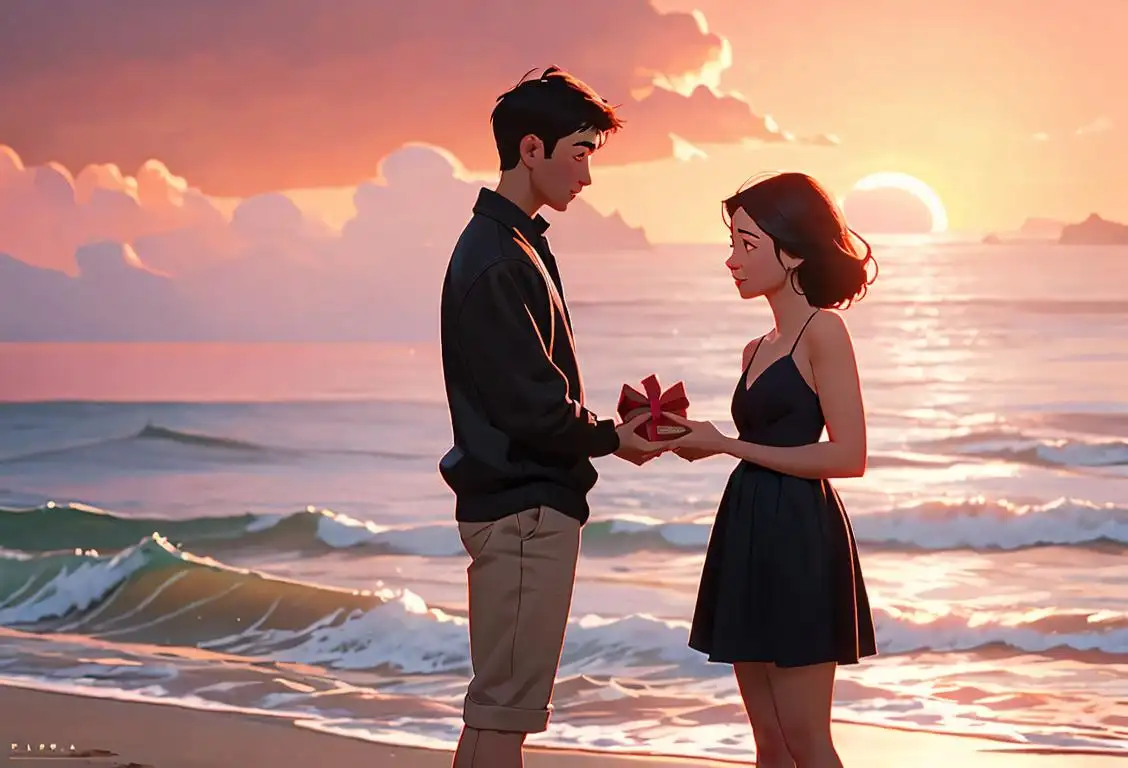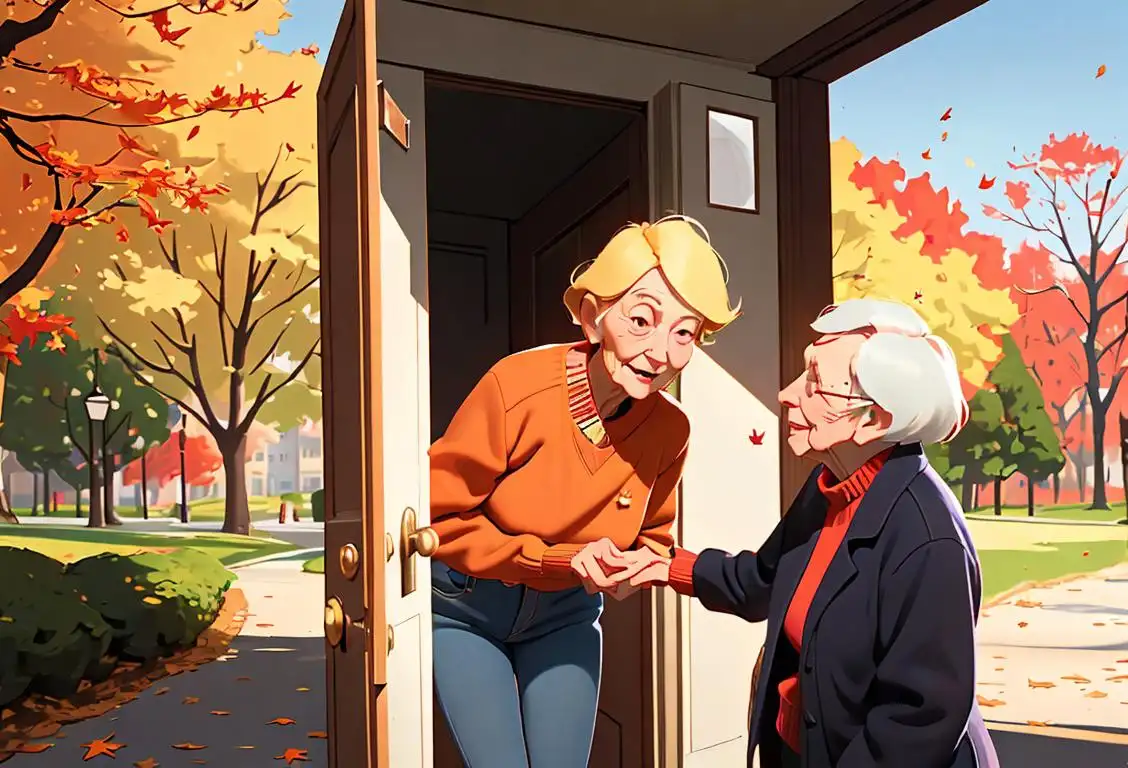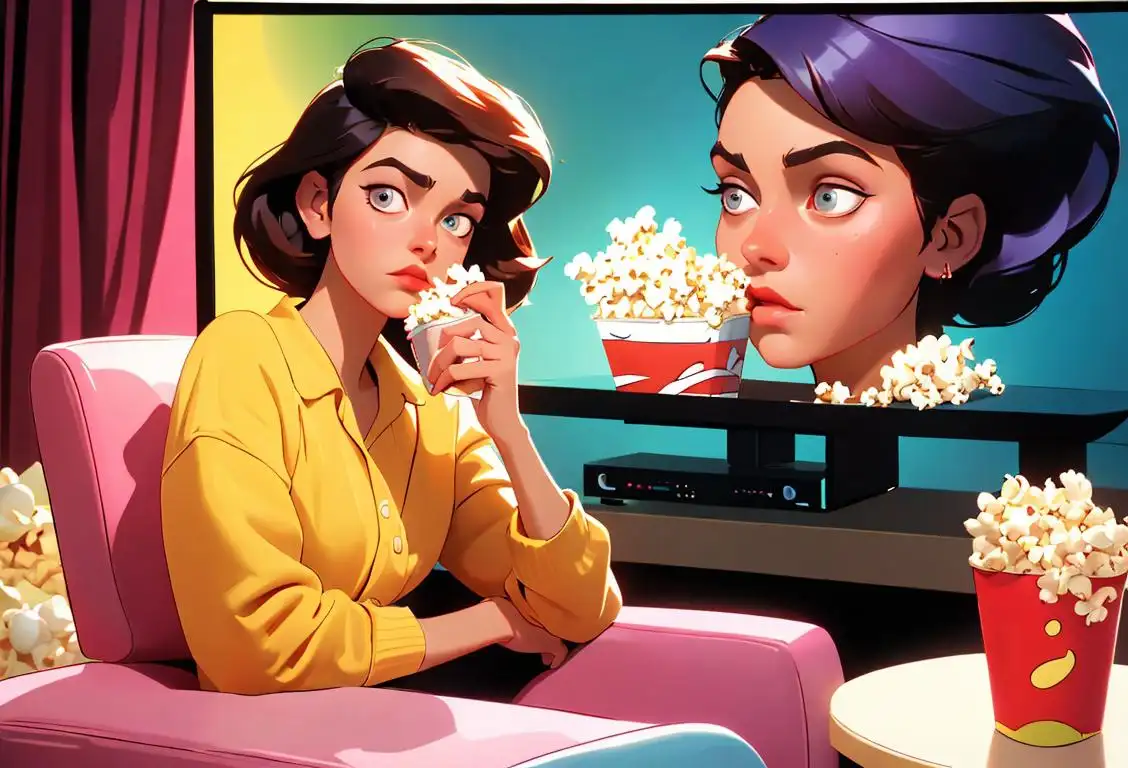National Engagement Day

Are you ready to take the plunge? It's National Engagement Day! Whether you're planning to pop the question or celebrating the person who put a ring on it, this day is all about the joy and excitement of engagement. From the nervously sweating palms to the heart-pounding anticipation, let's dive into the world of engagements and celebrate this special day with love and laughter!
When is Engagement Day?
It's national engagement day on the 26th December.
The History of National Engagement Day
While National Engagement Day might seem like a recent addition to the calendar, the concept of engagement has been around for centuries. The act of proposing, getting down on one knee, and asking the time-honored question, "Will you marry me?", is a tradition that has stood the test of time.
But why a day specifically dedicated to engagements? Well, it seems that people just couldn't contain their excitement and wanted a reason to celebrate the journey towards matrimonial bliss. National Engagement Day provides the perfect opportunity to honor the love, commitment, and the beginning of a new chapter in countless lives.
Ways to Celebrate National Engagement Day
So, how can you make National Engagement Day extra special? Here are a few ideas to help you celebrate:
- Plan a Surprise Proposal: If you're ready to pop the question, use this day as an opportunity to plan an unforgettable surprise proposal. From romantic rooftop dinners to flash mobs dancing to your favorite song, let your creative juices flow!
- Host an Engagement Party: Gather your loved ones and throw an engagement party to share the excitement with family and friends. It's a chance to toast the couple-to-be and celebrate their love with good food, laughter, and memories.
- Share Your Engagement Story: Take to social media and share your engagement story with the world. From the adorable and heartwarming to the hilarious and surprising, every engagement story is unique and worth telling.
- Start Wedding Planning: National Engagement Day marks the beginning of the journey towards tying the knot. Start brainstorming wedding ideas, envisioning your dream ceremony, and making the first steps toward planning your special day.
Did You Know?
Did you know that the average length of engagement varies across cultures? In the United States, the average engagement period is around 12 to 18 months. However, in some regions of India, engagements can last for several years - talk about a prolonged anticipation!
History behind the term 'Engagement'
1215
Origins in Legal Contracts
In the year 1215, the term 'engagement' first emerged in the context of legal contracts. It referred to a formal agreement between two parties, typically involving a promise to marry, a business transaction, or a future obligation. This usage of 'engagement' laid the foundation for its later connotations.
1450
Etymology of Engagement
The term 'engagement' traces its roots back to the year 1450. It is derived from the Old French word 'engagier,' meaning 'to pledge' or 'to promise.' The word was initially used in the context of making a formal agreement or commitment.
1475
Betrothal Contracts in Medieval Europe
In 1475, engagement was known as betrothal, and it was a common practice in medieval Europe for couples to enter into formal agreements called betrothal contracts. These contracts were usually made between families and involved a promise to marry their children at a future date. Betrothal contracts were legally binding and served as a way to solidify alliances and secure social status.
1225
The Origins of Engagement
Engagement, in the context of a romantic relationship, can be traced back to the 13th century. It originated from the Middle English term 'engagieren' which means 'to pledge oneself'. During this time, engagements were less romantic and more contractual, serving as a formal agreement between families to join their households or consolidate wealth and power.
1215
The Origin: Legal Agreements
The term 'engagement' originated in 1215, during the medieval period. At this time, it referred to a legal agreement or contract between two parties. Engagements often involved financial or property arrangements, such as betrothals or business deals. The term was mostly used in legal contexts and was derived from the Old French word 'engager,' which meant 'to pledge' or 'to bind.'
1792
Etymology of 'Engagement'
The term 'engagement' derives from the Old French word 'engagement', which means a pledge or promise. It further traces its roots to the Latin word 'angagementum', meaning to mortgage or engage. This original meaning of engagement refers to a legal agreement, typically involving a promise to marry or a contractual obligation.
1214
Emergence of the Term 'Engagement'
The term 'engagement' originated from the Old French word 'engagier,' which meant to pledge. It was first used in English in the year 1214 with the same meaning: a promise or agreement to marry. This term laid the foundation for the modern usage of 'engagement.'
1387
The birth of the term
The term 'engagement' first appeared in the English language in the year 1387. It stems from the Old French word 'engagement', which means a pledge or promise. This word was derived from the verb 'engagier', which means 'to pledge' or 'to promise'. The concept of making a commitment or promise in a relationship started gaining recognition during this time.
19th Century
Emergence of Modern Engagement Rings
During the 19th century, the tradition of giving engagement rings became popular. The idea of presenting a diamond ring as a symbol of engagement can be traced back to the Archduke Maximilian of Austria, who proposed to Mary of Burgundy with a diamond ring in 1477. However, it wasn't until the late 19th century that diamond engagement rings became more mainstream. The discovery of diamond mines in South Africa increased the availability of diamonds, making them more accessible for the general public.
1749
The legal significance
In 1749, the term 'engagement' took on a new meaning. It became legally significant in the context of marriage. An engagement was considered a formal agreement and a prelude to marriage. It involved a mutual promise of marriage between two individuals. This development solidified the term's association with romantic relationships.
1477
Emergence of Romantic Engagement
The concept of engagement began to transform during the late 15th century when Archduke Maximilian of Austria proposed to Mary of Burgundy with a diamond ring. This marked the beginning of romantic engagements. The use of a diamond ring as a symbol of commitment became popular among the nobility and upper classes, emphasizing the sentiment behind engagement.
1477
Symbolic Rings
During the year 1477, the concept of 'engagement' became strongly associated with the exchange of rings. Archduke Maximilian of Austria presented a diamond ring to Mary of Burgundy as a symbol of their pre-marital commitment. This event marked the start of the tradition of engagement rings, bridging the gap between contracts and sentimental gestures.
1477
Introduction of the Diamond Engagement Ring
In 1477, Archduke Maximilian of Austria proposed to Mary of Burgundy with a diamond engagement ring, marking the beginning of the tradition of using diamond rings as a symbol of betrothal. This trend became popular among the nobility and gradually spread to other social classes, making diamond engagement rings a cherished tradition globally.
1477
Royal Romance: Marriage Betrothals
In 1477, the term 'engagement' gained a new meaning associated with marriage. It became commonly used to describe the period of time between a marriage proposal and the actual wedding ceremony. This change in usage coincided with a significant event in European history: the engagement of Maximilian I, Holy Roman Emperor, to Mary of Burgundy. Their betrothal was celebrated with great pomp and marked the beginning of pre-wedding engagements becoming more prevalent among the nobility and upper classes.
1776
Engagement Rings
The tradition of using engagement rings to symbolize betrothal can be traced back to the year 1776. In this year, a jeweler named James Cox opened the first known jewelry shop in the United States. He is credited with popularizing the concept of engagement rings by introducing the idea of a diamond ring as a token of love and commitment.
1837
Engagement Rings Gain Popularity
In the Victorian era, Prince Albert presented Queen Victoria with an engagement ring. This romantic gesture gained popularity, and engagement rings became fashionable. Diamond rings symbolizing commitment and love became the go-to choice for engagement rings during this time. The phrase 'to be engaged' started being associated specifically with the promise to marry.
1800s
Expansion of Engagement Ring Tradition
During the 1800s, with the discovery of diamond mines in South Africa, the availability of diamonds increased, making them more accessible to the general public. This led to the expansion of the engagement ring tradition beyond the aristocracy, and diamond rings became a common symbol of engagement for people of varying social and economic backgrounds.
19th Century
Love and Romance: Emotional Engagement
During the 19th century, the concept of engagement started encompassing emotional commitment and romantic attachments. This shift was influenced by the changing societal attitudes towards love and marriage. Engagements took on a deeper meaning as couples began to exchange rings as a symbol of their commitment. Diamonds, a symbol of eternal love, also became popular in engagement rings during this period, thanks to successful marketing campaigns by diamond companies.
1869
Diamonds and De Beers
The year 1869 marked a significant turning point in the history of engagement rings. It was during this year that the diamond mining company, De Beers, was founded by Cecil Rhodes. De Beers would go on to play a major role in shaping the diamond market and promoting the idea that diamonds are synonymous with engagement and everlasting love.
1920s
The Rise of Diamond Engagement Rings
In the early 20th century, the De Beers Diamond Company launched an incredibly successful marketing campaign to promote diamond engagement rings. Their slogan 'A Diamond Is Forever' became synonymous with eternal love and solidified the diamond's association with engagements. This campaign increased the cultural significance of diamond rings and made them a common traditional choice for proposals.
1920s
Rise of Diamond Engagement Rings
The 1920s marked a turning point for diamond engagement rings. In 1938, the diamond company De Beers launched a highly successful advertising campaign with the slogan, 'A Diamond Is Forever.' This campaign aimed to associate diamonds with eternal love and forever commitment, ultimately solidifying the cultural connection between engagement and diamond rings. The marketing efforts of De Beers helped establish diamond engagement rings as a social norm.
1920s
Rise of the Engagement Photos
With advancements in photography technology, engagement photos started gaining popularity in the 1920s. Couples began taking formal portraits to commemorate their engagement. These photos often displayed the engaged couple dressed in their finest attire, showcasing their love and commitment to each other. Engagement photos continue to be a cherished tradition for many couples today.
1840
Royal Influence
In 1840, the term 'engagement' saw a significant cultural boost when Queen Victoria of England popularized the engagement ring trend. Following her engagement to Prince Albert, Victoria selected a gold ring adorned with diamonds as her token of commitment. The Queen's choice greatly influenced fashion and set a new standard for engagement rings.
1869
Diamonds in the mix
The year 1869 marks a significant milestone in the history of engagements with the discovery of diamond mines in South Africa. This discovery led to an increase in the availability of diamonds, which had previously been rare and expensive. The De Beers mining company cleverly marketed diamonds as a symbol of love and commitment, sparking a cultural tradition of giving diamond engagement rings.
1947
Tiffany & Co.'s Iconic 'Engagement Ring'
In 1947, Tiffany & Co. introduced their iconic engagement ring, aptly named the 'Tiffany Setting.' The ring featured a six-prong setting emphasizing the brilliance of the diamond. This design revolutionized the engagement ring industry and set a new standard for elegance and style, solidifying the notion of a diamond engagement ring as a symbol of love and commitment.
1947
The influence of Hollywood
The influence of Hollywood played a role in shaping the cultural significance of engagements in the 20th century. In 1947, the renowned actress Elizabeth Taylor received a stunning diamond engagement ring from her future husband, Michael Todd. This high-profile celebrity engagement garnered immense media attention and sparked a trend of using extravagant engagement rings as a display of wealth and status.
1947
Paparazzi Frenzy: Princess Diana's Engagement
Princess Diana's engagement to Prince Charles in 1981 generated unprecedented media attention and public interest. The couple's engagement announcement sparked a worldwide frenzy, with people closely following every detail of their courtship and wedding plans. Diana's engagement ring, featuring a stunning sapphire surrounded by diamonds, further popularized the trend of unique and non-traditional engagement rings. This event propelled engagements into the realm of pop culture, making them a highly anticipated and celebrated moment in a couple's journey.
1947
Media Spotlight
In 1947, 'engagement' received widespread attention when Princess Elizabeth (now Queen Elizabeth II) announced her engagement to Lieutenant Philip Mountbatten. This highly anticipated royal engagement captured the world's imagination, creating a media frenzy. The event further solidified 'engagement' as a cultural phenomenon celebrated by people worldwide.
1950s
Spreading Tradition and Cultural Impact
Engagement has become deeply ingrained in various cultures around the world, and during the 1950s, the tradition of exchanging engagement rings gained widespread popularity. The growth of the middle class and increased disposable income played a significant role in expanding this tradition. Engagement rings became more accessible and affordable for a broader range of people, further solidifying the cultural impact of engagements.
20th Century
Modern Engagement Celebrations
Throughout the 20th century, engagement rituals evolved to include various celebrations. Engagement parties became more common, providing an opportunity for family and friends to gather and celebrate the couple's commitment. Additionally, the tradition of proposing on one knee became popularized, often symbolizing respect and devotion. Engagement announcements in newspapers or through social media platforms are also customary ways of sharing the news with a wider audience.
1947
Diamonds Cemented as the Symbol of Engagement
In 1947, the De Beers diamond company launched its famous advertising campaign with the slogan 'A Diamond is Forever.' This marketing strategy successfully solidified the association between diamonds and engagement rings. The brilliance, durability, and rarity of diamonds made them the ultimate symbol of eternal love and commitment.
1938
The Diamond Engagement Ring Campaign
In 1938, the De Beers company launched a groundbreaking advertising campaign with the slogan 'A Diamond is Forever.' This campaign not only aimed to associate diamonds with eternal love but also influenced societal norms, making diamond engagement rings a symbol of social status and desirability. The campaign's success solidified diamonds as the go-to gemstone for engagement rings.
21st century
Expanding meanings
In the 21st century, the term 'engagement' has evolved beyond its original meaning. It now encompasses various contexts, including social media and marketing. Online platforms use the concept of 'engagement' to measure and analyze user interactions and involvement with content. Additionally, businesses often refer to customer engagement to gauge the level of interaction and loyalty a customer has with their brand.
1990s
Modern Practices
Since the 1990s, the term 'engagement' has expanded its meaning beyond just the act of promising to marry. In the digital age, 'engagement' gained significance in the realm of social media and marketing. It began to represent the level of interaction and interest between individuals or brands and their audience, indicating active involvement and fostering connections.
21st Century
Evolution and Personalization
In the modern era, engagement has evolved into a more individualized and personalized expression of love and commitment. Couples now have the freedom to choose non-traditional engagement rings, such as gemstone rings or even alternative symbols of commitment. Furthermore, engagements have extended beyond heterosexual relationships, promoting inclusivity and diversity in celebrating love and partnership.
21st Century
Evolution of Engagement Customs
In the 21st century, engagement customs have evolved to reflect the changing cultural landscape. While the diamond engagement ring remains popular, alternative gemstones, such as sapphires and emeralds, have gained prominence, offering unique and personalized choices. Additionally, non-traditional engagement rings, including vintage designs and custom-made settings, have become increasingly fashionable, allowing couples to express their individuality and creativity.
21st Century
Social Media and Public Declarations
In the 21st century, the concept of engagement has taken on new dimensions with the rise of social media. Many couples now publicly announce their engagements through Instagram, Facebook, or Twitter, sharing their joy with friends, family, and even strangers. Proposals have become more elaborate and creative, often shared as viral videos or social media posts. The term 'engagement' has evolved to include not only the commitment between two individuals but also the public declaration and celebration of their love.
Present
Evolution of Engagement
In modern times, the concept of engagement has expanded beyond mere betrothal and has become a significant cultural milestone. Engagement represents a commitment before marriage, symbolizing love, loyalty, and a shared future. While engagement rings remain prominent, the idea of what constitutes an engagement has diversified to include various expressions of commitment and dedication.
21st Century
Digital Age Engagements
As technology advanced in the 21st century, engagements increasingly took on a digital dimension. 'Digital engagements' emerged as a term to refer to proposals done through social media, video calls, or even virtual reality setups. Couples started sharing their engagement stories on various online platforms, making it possible to celebrate and share the exciting news with a wider audience.
Did you know?
Did you know that the average length of engagement varies across cultures? In the United States, the average engagement period is around 12 to 18 months. However, in some regions of India, engagements can last for several years - talk about a prolonged anticipation!Tagged
romance fun loved onesFirst identified
7th October 2015Most mentioned on
26th December 2016Total mentions
32Other days
Love Your Red Hair Day
Do Something Nice Day
Suicide Prevention Month Day
Kissing Fried Chicken Day
Kiss A Ginger Day
Iloveyou Day
Compliment Day
Happiness Day
Tv On The Same Day
Boyf Day









